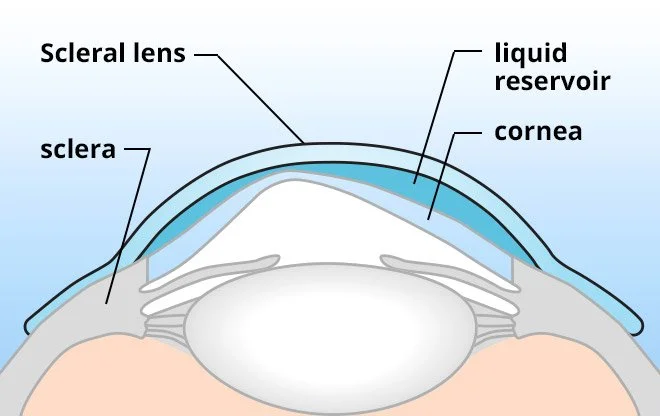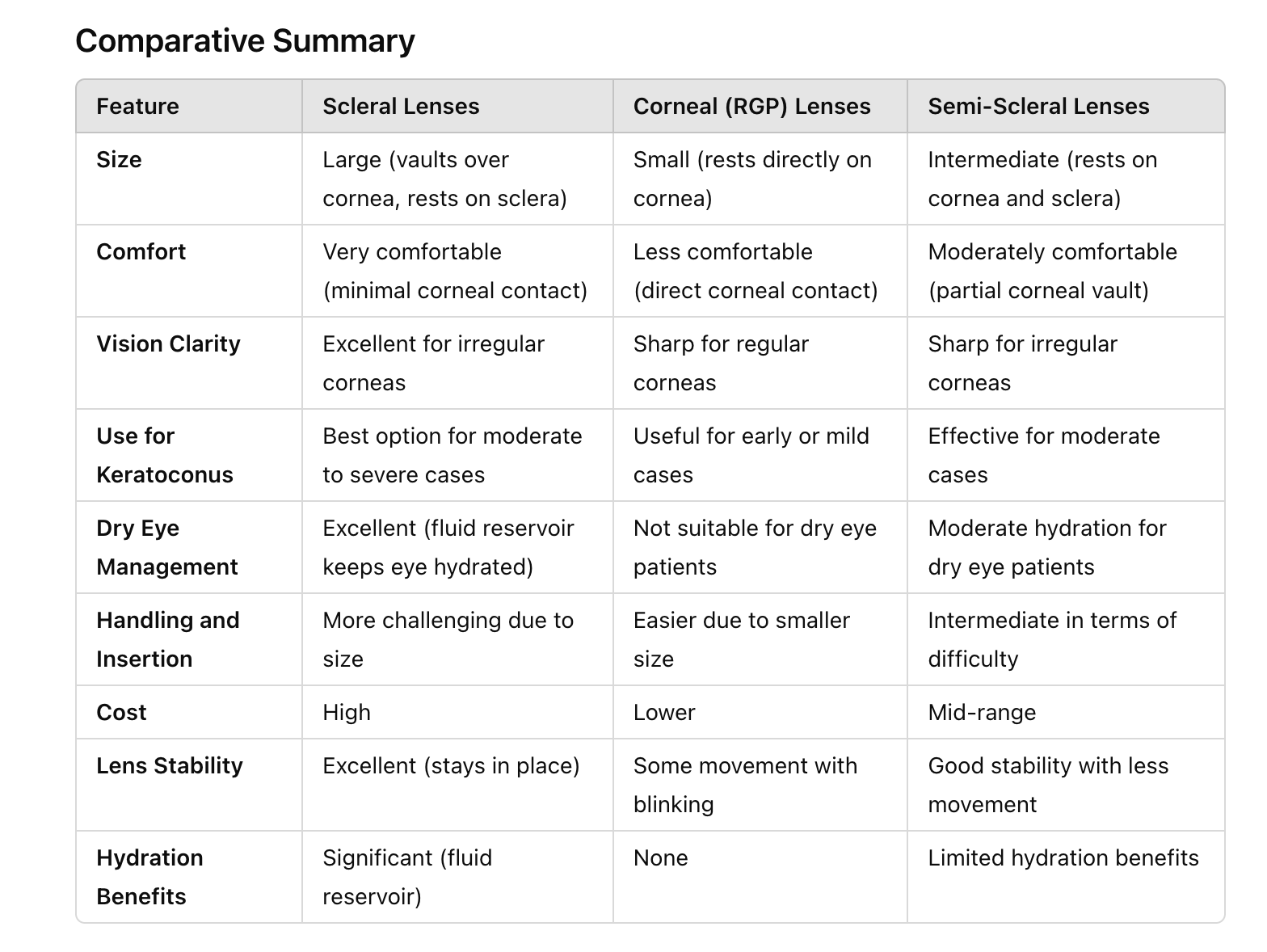Scleral Contact Lenses For Keratoconus and Irregular Corneas
When it comes to managing complex corneal conditions, optometrists often turn to a variety of rigid contact lens types. Among these, scleral lenses, corneal lenses, and semi-scleral lenses each have unique attributes and applications.
Scleral contact lenses have emerged as a game-changing tool in modern optometry. These large-diameter lenses, which rest on the sclera (the white part of the eye) rather than the cornea, have revolutionized how we manage a variety of complex corneal conditions. While initially designed for patients with irregular corneas, scleral lenses have found new and exciting uses in both clinical practice and everyday eye care. Here’s a closer look at the key benefits and expanding uses of scleral lenses in optometry.
Managing Keratoconus and Irregular Corneas
One of the most common applications of scleral lenses is for the management of keratoconus—a progressive condition where the cornea becomes thin and cone-shaped. For patients with keratoconus, traditional soft lenses often do not provide adequate vision correction or comfort due to the irregular corneal shape.
Scleral lenses, due to their larger size, vault over the cornea entirely and create a smooth optical surface. This results in significantly improved vision, offering clarity that most patients cannot achieve with other forms of lenses. In addition to keratoconus, scleral lenses are also highly effective for patients with post-surgical irregular corneas, such as after LASIK complications or corneal grafts.
Treating Severe Dry Eye Syndrome
Severe dry eye syndrome is another condition where scleral lenses shine. These lenses create a reservoir of saline between the back of the lens and the cornea, keeping the corneal surface constantly bathed in moisture. This makes them an excellent therapeutic option for patients with conditions like Sjogren’s syndrome or graft-versus-host disease (GVHD), where conventional treatments fail to alleviate severe dryness.
The protective barrier provided by scleral lenses helps reduce corneal exposure, irritation, and redness, enhancing comfort for individuals suffering from chronic dry eyes.
Vision Correction for High Refractive Errors
Patients with high astigmatism, hyperopia, or myopia often struggle to achieve clear vision with glasses or regular contact lenses. In cases where these refractive errors are too severe for traditional corrective lenses, scleral contact lenses offer a powerful alternative.
Because scleral lenses maintain a stable position on the eye and do not move with blinking, they provide sharper vision for those with significant refractive errors. Additionally, they reduce visual distortions commonly seen with standard soft lenses or glasses.
Ocular Surface Disease and Protection
Scleral lenses are now being used to treat a range of ocular surface diseases such as Stevens-Johnson syndrome, neurotrophic keratitis, and chemical burns. These lenses act as a protective shield for the cornea, reducing the risk of further damage and improving healing in cases of persistent epithelial defects.
By providing a mechanical barrier and a moist environment, scleral lenses also allow epithelial cells to regenerate, promoting faster healing and reducing discomfort for patients with ocular surface disease.
Post-Surgical and Trauma Management
For patients who have undergone corneal surgery, such as corneal transplants or LASIK, scleral lenses can help rehabilitate their vision. Post-surgical corneas can be irregular, leading to challenges with vision correction through glasses or regular lenses. Scleral lenses offer an optical solution that bypasses these irregularities, providing clearer vision and reducing post-surgical discomfort.
Similarly, for patients who have suffered from corneal trauma or scarring, scleral lenses can act as both a therapeutic and corrective device. The lenses protect the healing cornea while also correcting visual impairments caused by the trauma.
Improving Quality of Life for Patients with Complex Conditions
Patients with complex corneal conditions often experience a diminished quality of life due to both visual impairment and discomfort. Scleral lenses not only improve vision but also significantly enhance comfort, allowing patients to carry on with daily activities like driving, reading, and working.
For those with conditions such as ocular surface disease or limbal stem cell deficiency, scleral lenses often represent the difference between ongoing discomfort and a return to normalcy. Patients with chronic eye pain or discomfort have found scleral lenses to provide life-changing relief.
Comparisons between different hard contact lens types
When it comes to managing corneal conditions and providing customized vision correction, optometrists often turn to a variety of contact lens types. Among these, scleral lenses, corneal lenses, and semi-scleral lenses each have unique attributes and applications depending on the patient's specific needs. In this post, we’ll explore the differences and similarities between these lenses, examining how they compare in terms of comfort, visual clarity, therapeutic uses, and patient suitability.
Scleral Lenses
Overview
Scleral lenses are large-diameter gas-permeable lenses that vault over the entire corneal surface and rest on the sclera (the white part of the eye). They create a fluid reservoir between the cornea and the lens, making them ideal for patients with corneal irregularities and ocular surface diseases.
Best Suited For:
Keratoconus
Irregular corneas
Severe dry eye syndrome
Ocular surface disease (Stevens-Johnson syndrome, neurotrophic keratitis)
High refractive errors
Advantages:
Superior comfort: By vaulting over the cornea, these lenses don’t touch sensitive corneal tissue, reducing irritation.
Fluid reservoir: The fluid layer underneath helps keep the cornea hydrated, which is critical for patients with severe dry eye.
Stable vision: Scleral lenses remain stable on the eye, offering consistent vision without lens movement.
Disadvantages:
Larger size: Due to their larger size, handling and insertion can be more challenging for some patients.
Reduced tear exchange : There is little to no tear movement behind a scleral lens, which may lead to reduced oxygen transmission. For most patients, this is not an issue but it can become a problem in specific situations where oxygen requirements are higher (such as corneal grafts). It may also lead to accumulation of mucous behind the lens - leading to fogging in some wearers.
Cost: Scleral lenses tend to be more expensive than other types of lenses, both in terms of the lenses themselves and the specialized fitting process.
Corneal Lenses (Rigid Gas Permeable - RGP)
Overview
Rigid Gas Permeable (RGP) lenses are smaller, hard lenses that sit directly on the cornea. They are commonly used to correct vision in patients with regular corneas and mild to moderate astigmatism, as well as for those with keratoconus in earlier stages.
Best Suited For:
Mild to moderate astigmatism
Early-stage keratoconus
General refractive errors (myopia, hyperopia)
Advantages:
Tear exchange: RGP lenses allow more tear movement behind the contact lens than any other lens type, which is ideal for oxygen transmission.
Durability: They are long-lasting and resistant to wear and tear.
Smaller size: Their smaller diameter makes them easier to insert and remove for many users.
Disadvantages:
Less comfort:
Limited hydration: RGP lenses do not provide the hydration benefits that scleral lenses do, which can be an issue for patients with dry eyes or corneal disease.
Lens movement: These lenses tend to move with each blink, which may cause discomfort and fluctuating vision in some patients with more severe corneal distortion.
Semi-Scleral Lenses
Overview
Semi-scleral lenses are a hybrid between corneal and scleral lenses. They are larger than corneal RGP lenses but smaller than full scleral lenses, resting on both the sclera and the cornea. They are designed to provide a combination of comfort and vision correction for patients who need more than what a standard corneal lens offers but may not require a full scleral lens.
Best Suited For:
Moderate keratoconus
Irregular corneas (mild post-surgical cases)
Moderate dry eye
Advantages:
Improved comfort: Semi-scleral lenses offer more comfort than corneal lenses by vaulting part of the cornea, reducing the pressure on the sensitive central cornea.
Stable vision: Like scleral lenses, semi-scleral lenses are more stable than corneal lenses, providing consistent vision.
Less lens movement: They stay more centered compared to RGP lenses, reducing the visual disturbances caused by lens movement.
Moderate tear exchange: semiscleral lenses allow more tear movement behind the contact lens than sclerals, which is ideal for oxygen transmission.
Disadvantages:
Intermediate size: Although they are smaller than scleral lenses, they can still be more challenging to handle compared to corneal lenses.
Fluid reservoir is limited: While semi-scleral lenses do offer some hydration benefits, they do not create as significant a fluid reservoir as full scleral lenses, which can limit their effectiveness for severe dry eye cases.
Conclusion
Each type of lens—scleral, corneal, and semi-scleral—offers unique benefits depending on the patient’s specific condition, refractive needs, and comfort preferences. For patients with irregular corneas, severe dry eyes, or ocular surface disease, scleral lenses provide unmatched comfort and therapeutic benefits. In contrast, corneal lenses are suitable for those needing sharp vision correction in cases of regular corneas or early-stage keratoconus. Semi-scleral lenses, as a hybrid option, offer a middle ground for patients who need more support than RGP lenses but do not require the full vaulting effect of scleral lenses.
Ultimately, the choice of lens depends on the patient's ocular health, lifestyle, and specific visual needs. Consulting with an eye care professional will ensure that patients receive the most appropriate and effective solution for their condition.
Author Bio
Jenny Wu is an optometrist based in Canberra, Australia. She is a full scope optometrist specializing in dry eye, specialty contact lenses, myopia control, and orthok. She practices at Simpson Optometry. In her spare time she enjoys spending time in nature, photography, gardening, and being with her husband (also an optometrist) and 2 children.



